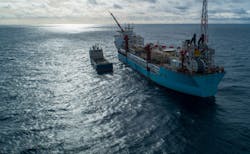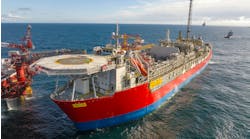Offshore staff
GODALMING, UK – Hurricane Energy has provided a detailed update on the early production system at the basement Lancaster oil field west of Shetland through the FPSO Aoka Mizu.
Downhole pressure gauges in both Lancaster’s wells suggest reservoir pressure has declined by 120 psi (8.27 bar) following cumulative production to date of 6.6 MMbbl of oil. The rate of decline is higher than was anticipated in pre-production reservoir modeling, indicating a shallower oil-water cut (OWC) and lower oil-in-place volumes than estimated in the 2017 Competent Person Report.
Reservoir modeling based on the probable initial OWC at 1,330 m (4,363 ft) TVDSS, matched to observed dynamic behavior, suggests the OWC may have moved up by 10-15 m (33-49 ft) since the start of production and is now within the 205/21a-7z reservoir section. This well is thought to be ‘coning’ oil from above when flowing at higher rates.
Pressure gauges in the suspended 205/26b-14 Lincoln well 8 km (5 mi) away exhibit a 20-psi (1.38-bar) pressure decline, probably due to production from the Lancaster field. This suggests good regional reservoir connectivity and that the Brynhild fault zone between Lancaster and Lincoln likely does not seal.
However, additional pressure data will be needed following a scheduled Lancaster maintenance shut-in to confirm that Lancaster is the cause of the depletion.
While the rate of pressure decline with cumulative production has slowed, well flowing pressure may approach the point at which gas is freed from oil within the reservoir, requiring the two wells to be choked back in order to manage excess gas production.
Lancaster appears to be a more complex reservoir system than predicted, with the onlapping sandstones appearing to represent a substantial part of the presumed connected volume. Further work will be needed to assess the potential implications for field development and ultimate recovery.
Assuming production has to be choked back as well flowing pressure approaches ‘bubble point’ during H2 2021, remaining reserves that could be recovered via the current EPS through the two wells with no further activity is 9.4 MMbbl (subject to an economic limit test).
Hurricane is assessing options to mitigate the forecast production and pressure decline rates of the EPS, the main one being to manage reservoir voidage and pressure decline by initiating water injection.
It is also assessing the optimum timing, cost, location and design of a water injection well and facilities, including adaptations to existing water injection capabilities on the FPSO. Hurricane estimates the total cost, including drilling at $70-80 million.
09/14/2020



